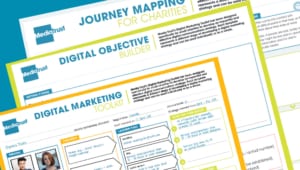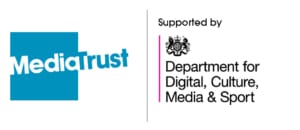Building your charity’s Theory of Change: A beginner’s guide
Struggling to communicate your charity’s impact clearly? This beginner's guide will help you build a strong Theory of Change
Posted 14 May 2025

Our Digital Marketing Strategy Toolkit is a set of four templates designed to help charity leaders and those involved in their charity's marketing and communications develop and implement an effective digital marketing strategy. Digital marketing expert, Jo Kerr explains why we created the toolkit and how you can use it to transform your charity's digital communications. You can work your way through the templates step-by-step or use them individually if you only want to focus on a specific aspect of your digital marketing strategy.
In March 2019 Media Trust delivered the Digital Leadership Programme and as the trainer, I had the opportunity to travel around England and train 138 charity leaders as part of the Department for Digital, Culture, Media & Sport Digital Leadership Fund.
The training was delivered through a partnership between Media Trust, the FSI and the Association of Chairs. Content covered the full spectrum of effective communications and good digital leadership for smaller charities.
Every organisation I met had already made some great steps forward with digital — many teams knew how to write effective posts for social media, they were sending regular emails, their websites already communicated clear information to their users.
The CEOs, directors and trustees in our Digital Marketing Strategy training were ready to take things to the next level of digital maturity. They wanted to take a step back and think about digital marketing and communications in a more planned way that would get better results. With this in mind, we created the Digital Marketing Strategy Toolkit to guide charities through the stages of implementing a digital marketing strategy.
Whether you attended one of the sessions, or you’re looking for some online resources to kick-start your digital marketing strategy, this toolkit is for you.
Although these resources were designed with third-sector leaders in mind, the learnings are relevant to anyone who is keen to implement digital transformation within their organisation.
You can download the entire toolkit in one go or click on the links below to download each template individually, working your way through each one-by-one, using the detailed instructions on each accompanying web page.
Once you download the templates you can either print them out or work on them directly on your computer.

If the download is not working please ensure you disable your ad blocker or try a different browser.
I hope these tools will help you make your digital marketing and communications more effective. Media Trust would love to hear how you get on so please do share your feedback.

Struggling to communicate your charity’s impact clearly? This beginner's guide will help you build a strong Theory of Change
Posted 14 May 2025

Packed with expert advice, practical tips, and industry resources, this toolkit is designed to help support under-represented talent step into advertising with confidence.
Posted 16 April 2025

You’ve got the idea - now let’s plan a charity livestream that runs smoothly and gets great results.
Posted 15 April 2025
